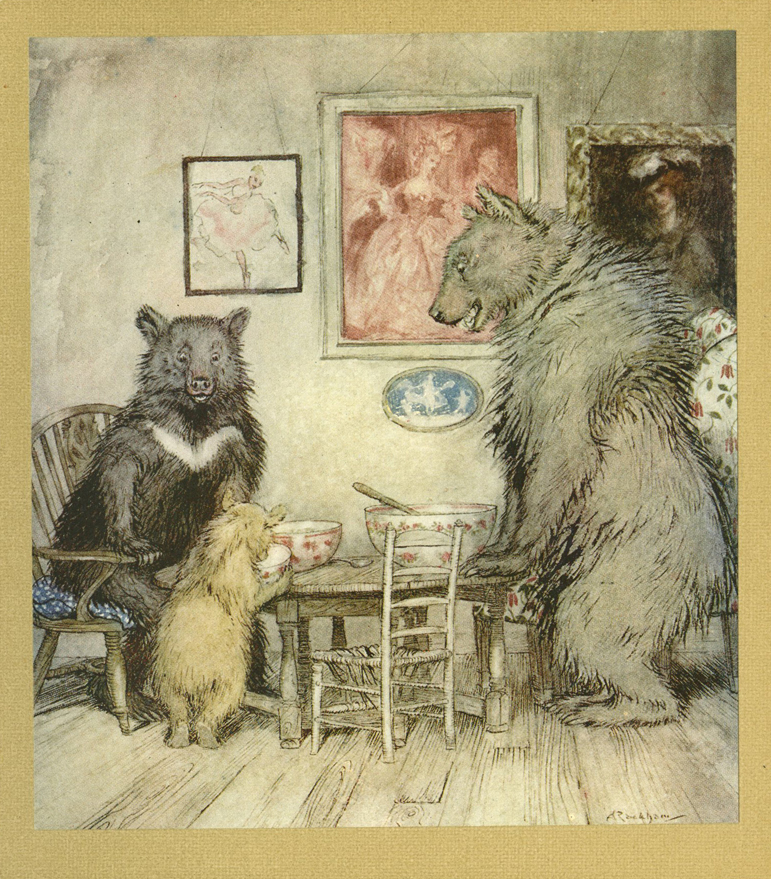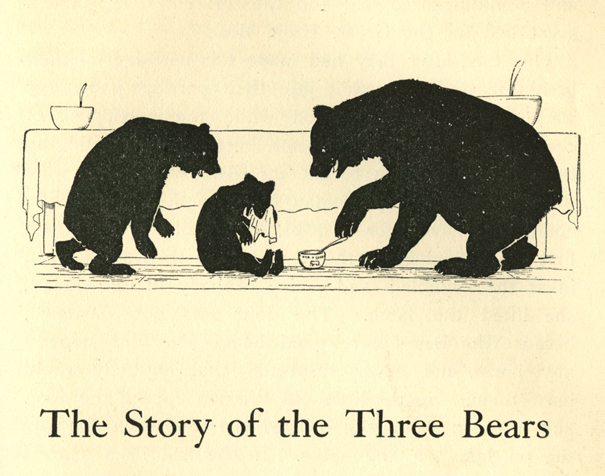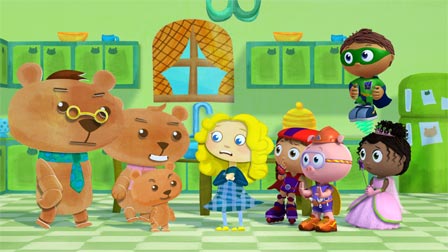By: Sydney Vollmer
 In our present time, it seems stories are constantly being changed or redone to make them more applicable to our lifestyle. This certainly isn’t an entirely new phenomenon in the course of literature, but the frequency seems to be picking up. Like any other content, fairytales are not excluded in this world of remakes, but how much are we allowed to change things? How does it impact the future generations who are learning these stories for the first time?
In our present time, it seems stories are constantly being changed or redone to make them more applicable to our lifestyle. This certainly isn’t an entirely new phenomenon in the course of literature, but the frequency seems to be picking up. Like any other content, fairytales are not excluded in this world of remakes, but how much are we allowed to change things? How does it impact the future generations who are learning these stories for the first time?
We all know the story of Goldilocks and the Three Bears. I can’t say what version you first heard, but I would bet it was the same one I learned as a kid. My preschool teachers, parents, and Stella the Storyteller from Barney all told me this story about a family of bears who lived in the woods. There was a Mama Bear, a Papa Bear, and a Baby Bear. One morning, they make porridge for breakfast. It’s too hot to eat right away, so they take a walk while it cools. That same morning, a little girl named Goldilocks is walking through the woods and sees their house. She goes in for whatever reason—be it curiosity, tiredness, hunger, or what-have-you. Once inside, she sees the porridge and goes to eat it. Papa’s is too hot. Mama’s is too cold. Baby’s is just right and she gobbles it up. In the living room, Goldilocks sees three chairs. Papa’s is too hard. Mama’s is too soft. Baby’s is just right…but she breaks it. Sleepy now, she heads to the bedroom. Papa’s bed is too hard. Mama’s bed is too soft. Baby’s bed is just right, and that’s where the bears find her when they come home from their walk and discover the mess she made in their house. Goldilocks wakes up and runs past the bears, down the stairs, and all the way home. She then learns her lesson and never enters into a home without permission again. Sound familiar? Good.
The original tale isn’t very different, except instead of Goldilocks being a little girl she is an unnamed, old woman—and she curses each time something doesn’t go her way. Even when she eats all of Baby Bear’s porridge, she’s mad the bowl couldn’t hold more. And Baby Bear—not a baby. In fact, the bears were originally not a family, but bachelor bears—one was huge, one was medium-sized, and one was tiny. Finally, maybe the most important change is when the old woman wakes up. She does not run past the bears. Instead, she jumps from the second-story window. It is left up to the reader to decide whether she dies in the fall or is able to run away, but I think we all know in our hearts what the answer is.
Within my office here in the Archives & Rare Books Library, at this very moment I have two versions of this story—one from the collection of English Fairy Tales collected by Joseph Jacobs, published in 1890, and one from English Fairy-Tales Retold by F. A. Steel, which was published in 1918. The two versions bear a strong resemblance to one another. In fact, the only differences are a few words and phrases here and there and the change of the old woman into Goldilocks. The supposed reason behind this change was to make the story more appealing for young children. At the time, there were more stories about little, old women than there were about little girls. It was also decided that making the character attractive rather than ugly would be more appealing to readers. That change was made nearly 100 years ago, and the story has stayed fairly constant since then…until now. Children today may be learning the story a bit differently thanks to a show called Super Why!
Super Why! shares the objective of many kids’ shows: teaching children basic skills. This show focuses on reading, basic manners, and problem-solving skills. The series takes place in “Storybook Village.” All the usual characters live there, including Goldilocks and the Three Bears. The plot of a typical episode goes as follows: a storybook character comes to the group of friends, known as the Super Readers, with a “Super Big Problem.” The Readers know they can look in a book to help them solve said problem. They then delve into a fairytale, encountering obstacles along the way. Each obstacle they successfully overcome awards them with “Super Letters.” At the end, these Super Letters come together to spell out the answer to their original Super Big Problem. That all sounds great. But what happens when they start changing these classic stories for the purpose of teaching the children a real-life application of a moral?
Let’s look at their episode on Goldilocks and the Three Bears.
We open to see one of the Super Readers, Whyatt, showing us around his big brother’s room. In the process of showing us how his big brother spends his time he completely trashes the room! (*GASP*) He feels so terrible, because he didn’t mean to do it and now his brother is mad at him. He’s not sure how to fix things so he assembles the Super Readers, who take a dive into Goldilocks and the Three Bears.
Goldilocks causes her usual mayhem, but the end of the episode doesn’t leave her shrieking through the house at the discovery of three bears living there. In this version, Goldilocks knew the house belonged to the Three Bears. She was just waiting for them to get back and she became bored. Amazingly, Goldilocks never notices she is making a mess. As soon as it strikes her that she might have inconvenienced the Bears, she decides to clean up everything she destroyed. Upon the Bears’ return, Mama Bear is thrilled someone mopped her floor and Baby Bear is happy when Goldilocks offers to make him more porridge. What about the Super Letters you ask? NLECA PU. For those of you who don’t feel up to an anagram right now, it unscrambles to “CLEAN UP.” Whyatt goes back to his house and cleans up his brother’s room. He apologizes and everything is hunky-dory. Everyone is happy. So what’s my problem?
I have no problem with the lesson the story gives. Children should learn to clean up and apologize for their actions. Often, it does result in being forgiven. But the show takes a cautionary tale and turns it into a Happily Ever After. Why? Do we not get enough of that with Cinderella and the like? Could we not let children know that sometimes apologizing isn’t enough? That it’s wrong to not apologize in the first place? That sometimes things don’t have the ending we hope for?
I’m all for children learning from the things they watch and read, but I think they could still learn the lesson if the story had its original ending. I actually think the children would learn more that way, because they get to come up with the answer on their own. Let’s see…That whole being disrespectful of property thing didn’t really work for Goldilocks. Maybe I shouldn’t touch this thing that’s not mine. And if they do touch it: Maybe if Goldilocks had tried apologizing to the Three Bears, things would have ended differently. Maybe I can apologize to my mom for breaking her favorite coffee cup. Create educational stories. Let children watch educational TV. But don’t forget to let children learn by actually thinking for themselves. They’re smarter than we give them credit for.
If you would like to learn the original forms of fairytales so you can tell them to your child, please come see our collection of rare editions, many illustrated by Arthur Rackham and Edmund Dulac. We would love to share this world of fantasy and sometimes unhappy endings with you. Call us at 513.556.1959 or email us at archives@ucmail.uc.edu. You can also visit us on the web at http://www.libraries.uc.edu/arb.html and our Facebook page can be found at https://www.facebook.com/ArchivesRareBooksLibraryUniversityOfCincinnati where we post all sorts of delights every day. We’re open Monday through Friday, 8am-5pm. In the meantime, don’t go into any unfamiliar houses, and if you do, just steer clear of second-story windows.


